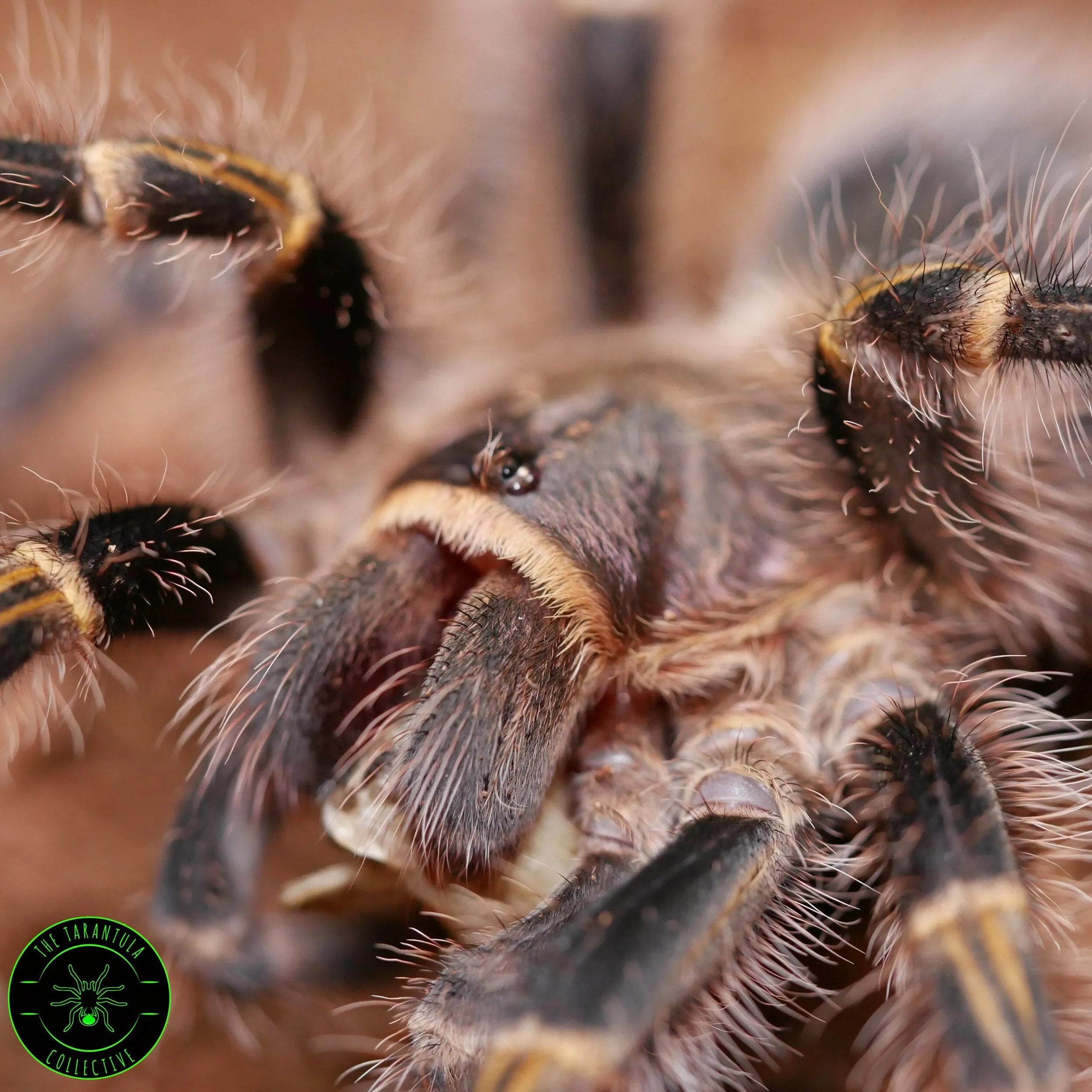Understanding Chaco Golden Knee Tarantula Slings
Caring for a Chaco Golden Knee tarantula sling can be a rewarding experience, but it requires understanding and dedication. These fascinating creatures, known for their striking appearance and relatively docile temperament, are popular choices for both beginner and experienced tarantula keepers. This comprehensive guide will provide you with all the necessary information to ensure your Chaco Golden Knee tarantula sling thrives, from setting up its enclosure to understanding its specific needs regarding feeding, watering, and overall health. By following these guidelines, you can create a comfortable and enriching environment for your new pet, allowing you to enjoy observing its unique behaviors and remarkable growth.
Origin and Characteristics
The Chaco Golden Knee (Grammostola pulchra) originates from the grasslands of southern Brazil and Paraguay. In their natural habitat, they burrow in the ground and are exposed to specific climatic conditions that you must replicate in captivity. As slings, these tarantulas are small and vulnerable, requiring a carefully controlled environment to ensure their survival and healthy development. This species is known for its relatively gentle nature, making them less likely to bite when compared to other tarantula species, although caution is always advised. Their lifespan can be quite long, with females often living for 20 years or more, providing you with a long-term companion and a fascinating insight into the world of arachnids.
Appearance and Identification
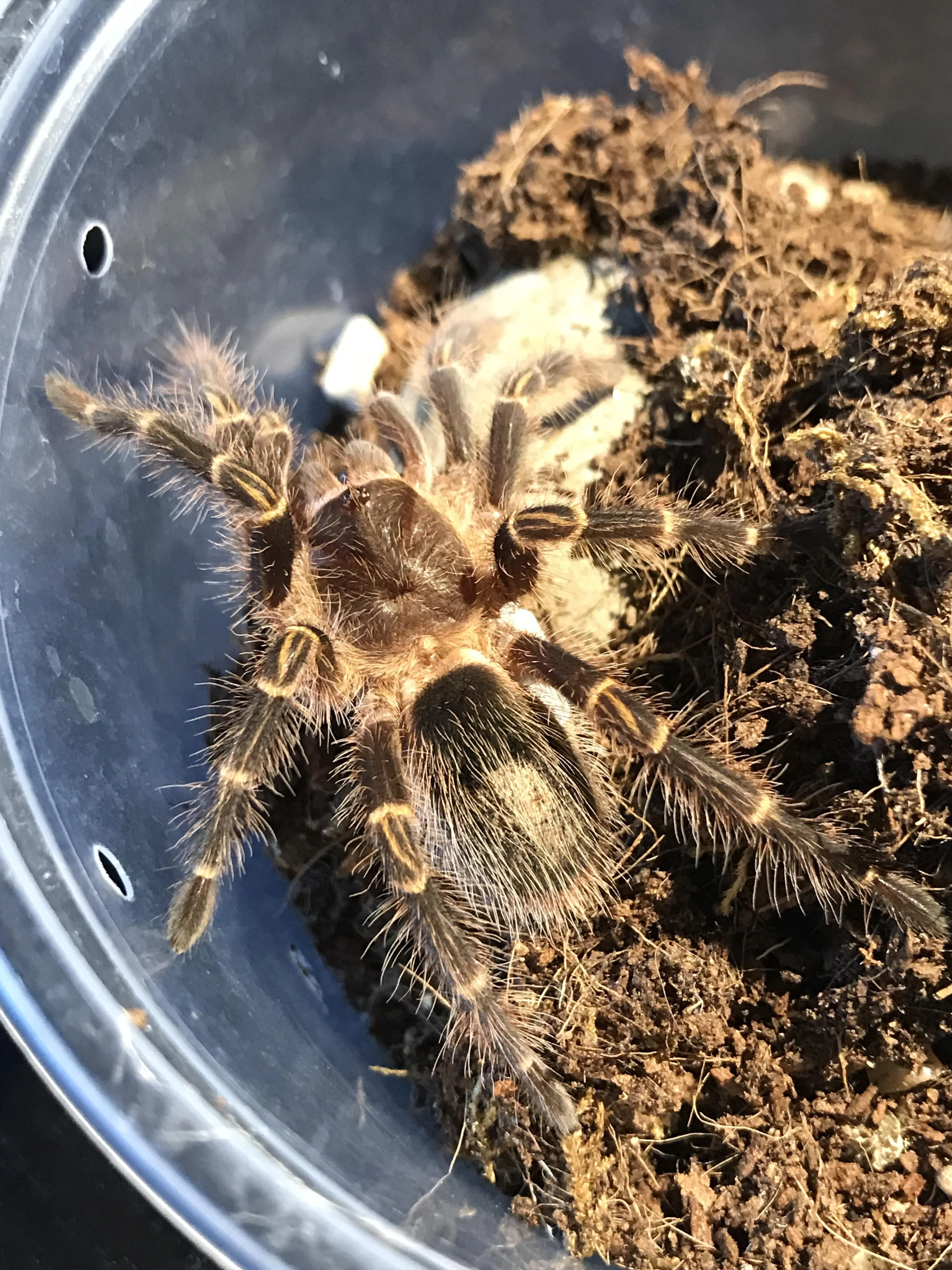
Chaco Golden Knee tarantula slings are immediately recognizable by their distinctive coloration, even at a young age. They have a black body with golden-orange markings on their knees and legs, which become more pronounced as they mature. These vibrant colors contribute to their appealing appearance, making them visually captivating pets. As they grow, the contrast between the black carapace and the golden stripes becomes even more striking. The sling stage is particularly delicate, where their exoskeletons are soft and more vulnerable, so it is important to be extremely careful while handling them. Identifying a healthy sling involves looking for a plump abdomen, active behavior, and clear coloration, which are all indicators of a well-cared-for tarantula.
Creating the Perfect Enclosure
Setting up the right enclosure is crucial for the well-being of your Chaco Golden Knee tarantula sling. The environment should mimic their natural habitat as closely as possible to help them thrive. This involves choosing the correct size of enclosure, selecting appropriate substrate, and maintaining the right levels of ventilation, humidity, and temperature. A well-designed enclosure will not only provide a safe and comfortable living space for your sling but also allow you to observe its behavior and ensure its health. Attention to detail in these areas will contribute significantly to your success as a tarantula keeper and the overall health and happiness of your Chaco Golden Knee tarantula.
Choosing the Right Size
For a Chaco Golden Knee tarantula sling, a small, appropriately sized enclosure is essential. A deli cup or a small plastic container with secure ventilation holes works well. The enclosure should be approximately 2-3 times the diagonal leg span of the sling in width and length, allowing ample room for movement without overwhelming the sling. As the sling grows, you will need to upgrade the enclosure accordingly. Avoid oversized enclosures, as they can make it difficult for the sling to find food and water, and they may feel insecure. Make sure the enclosure has a secure lid to prevent escape, as tarantulas are skilled escape artists. A properly sized enclosure promotes both comfort and a sense of security for your sling.
Substrate Selection

The substrate, or bedding, you choose is crucial for maintaining the right humidity levels and providing a comfortable environment. A mixture of peat moss, coconut fiber, and a small amount of vermiculite works well. These materials retain moisture effectively, which is essential for the Chaco Golden Knee’s health, particularly during molting. The substrate should be deep enough for the sling to burrow, which is a natural behavior. Avoid using sharp or abrasive substrates that could injure the tarantula. Regularly check the substrate for mold or excessive dryness and replace it as needed to maintain optimal conditions. The correct substrate supports the sling’s natural behaviors and contributes to its overall well-being, providing a sense of security and aiding in healthy development.
Importance of Ventilation
Adequate ventilation is crucial to prevent the buildup of harmful gases and the growth of mold and fungus. Ensure the enclosure has ventilation holes on the sides and the top. Good airflow helps regulate humidity, prevents stale air, and reduces the risk of respiratory problems in your sling. Make sure the ventilation is sufficient but not excessive, as too much airflow can dry out the enclosure too quickly, which can be harmful. The number and size of the ventilation holes should be appropriate for the size of the enclosure, and the environment the sling lives in. Regularly inspect the ventilation holes to ensure they are not blocked by substrate or debris. Proper ventilation is an essential aspect of creating a healthy environment for your Chaco Golden Knee tarantula sling, which can extend its lifespan and ensure overall happiness.
Humidity and Temperature Control
Chaco Golden Knee tarantulas thrive in specific humidity and temperature ranges. Maintain a humidity level of 65%-75% by lightly misting one side of the enclosure a few times a week. Avoid over-misting, as this can lead to mold growth. The temperature should be kept between 75°F and 85°F (24°C and 29°C). Use a thermometer to monitor the temperature and a hygrometer to measure humidity. During colder months, you might need to use a heat mat on the side of the enclosure, but be cautious, so the temperature does not get too high. By carefully managing humidity and temperature, you create the ideal living conditions, which promotes molting, feeding, and overall health for your Chaco Golden Knee tarantula sling.
Feeding Your Sling
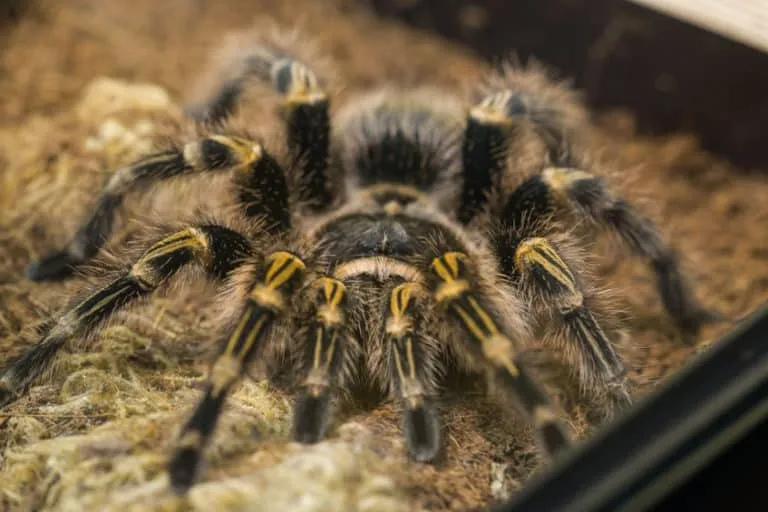
Feeding your Chaco Golden Knee tarantula sling is a crucial aspect of its care. Providing the right type of food and adjusting feeding frequency and portion size are key to ensuring healthy growth. Proper feeding practices help your sling develop a strong exoskeleton and maintain good overall health. It is important to observe your tarantula’s eating habits and adjust accordingly, since tarantulas have unique needs and can be affected by many factors. Understanding how to feed your Chaco Golden Knee tarantula will contribute to its longevity and ensure that it thrives.
Appropriate Food Choices
The best food for a Chaco Golden Knee tarantula sling consists of small, live insects. Crickets and flightless fruit flies are common choices. Other options include small mealworms or roaches, but they can be more difficult for the sling to catch. Always ensure that the insects are gut-loaded with nutritious food for at least 24 hours before offering them to your tarantula. This ensures that the sling receives the maximum nutritional value. Avoid feeding your sling insects that have been exposed to pesticides or insecticides. Variety in the diet can also be beneficial. Small amounts of pre-killed insects can be used, but they are often less appealing to slings. Providing a variety of appropriately sized and nutritious food helps your sling grow into a healthy adult tarantula.
Feeding Frequency and Portion Size
The feeding frequency for a Chaco Golden Knee tarantula sling depends on its size and growth rate. Generally, feed slings 1-2 times per week. Observe your tarantula’s abdomen; if it looks plump and full, reduce the feeding frequency. The portion size should be appropriate for the sling’s size. Offer one or two appropriately sized insects per feeding. Remove any uneaten food within 24 hours to prevent the build-up of mold or mites. As the tarantula grows, you can increase the portion size and potentially decrease the feeding frequency. Regularly monitor your sling’s appetite and adjust the feeding schedule accordingly. Providing the right amount of food is critical for helping your sling achieve a healthy growth rate without overfeeding, supporting a long and healthy life.
Watering and Hydration
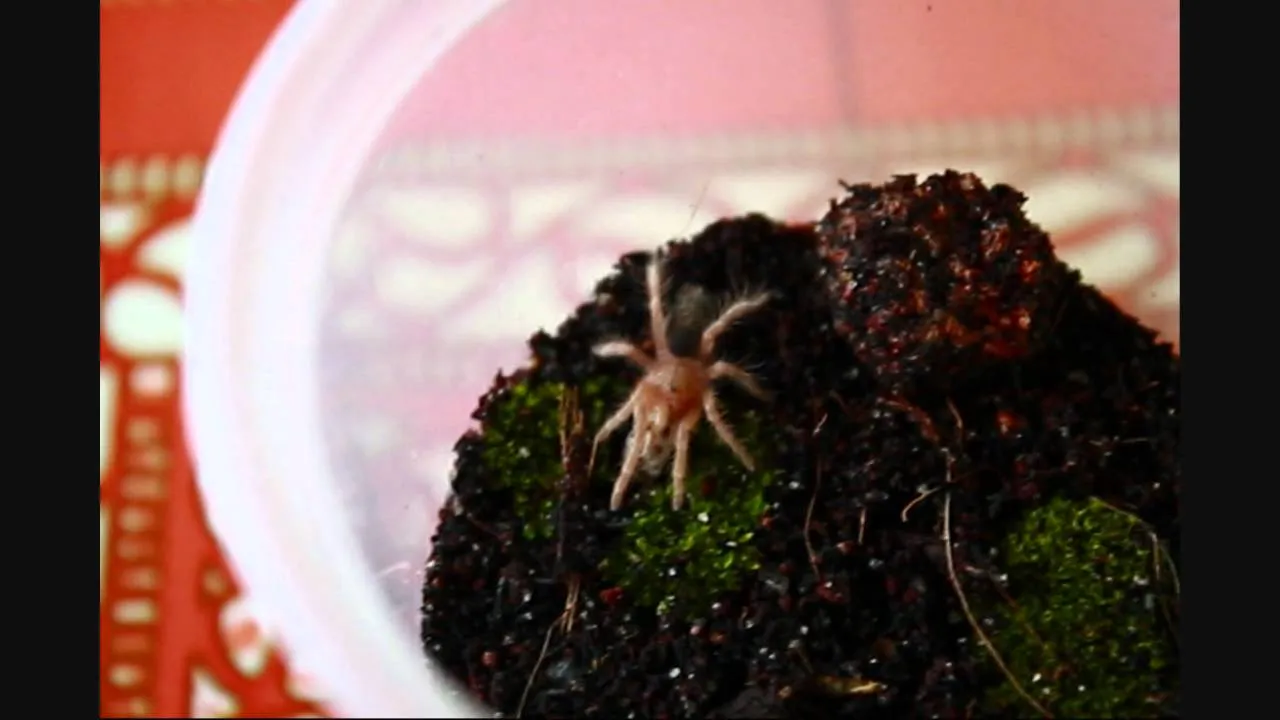
Proper hydration is essential for the health and well-being of your Chaco Golden Knee tarantula sling. They need access to fresh water to stay hydrated and to aid in molting. Providing a consistent water supply helps keep your tarantula healthy and comfortable. Regular watering practices, combined with appropriate humidity levels, are key to ensuring your sling’s well-being. This approach helps your sling thrive in captivity, so you can enjoy your pet and witness its unique development.
Providing Fresh Water
Always provide your Chaco Golden Knee tarantula sling with access to fresh water. You can use a shallow water dish, such as a bottle cap or a small dish specifically designed for tarantulas. The dish should be small enough that the sling cannot fall in and drown. Ensure that the water dish is always clean. Change the water at least once a week, and more often if it becomes soiled. For smaller slings, you might consider using a damp cotton ball instead of a water dish. Monitor the water level and refill as needed, ensuring that your sling always has access to a safe and clean water source, which will ensure that your pet has the ideal opportunity to thrive.
Misting Techniques
In addition to a water dish, misting the enclosure can help maintain the appropriate humidity levels. Use a spray bottle filled with dechlorinated water and mist one side of the enclosure lightly every few days. Do not over-mist, as this can lead to mold growth and other issues. Aim the mist towards the sides of the enclosure rather than directly at the tarantula. Monitor the humidity levels with a hygrometer to ensure they remain within the ideal range. Misting is particularly important during molting. Misting properly supports molting and helps in overall health, promoting a comfortable and healthy environment.
Handling and Safety Precautions

Handling a Chaco Golden Knee tarantula sling should be approached with caution. While this species is known for its docile nature, it is crucial to prioritize the safety of both the tarantula and yourself. Understanding when to avoid handling, recognizing stress signals, and taking the necessary precautions are vital for the well-being of your pet. Developing a cautious approach will lead to a better experience and long term relationship with your tarantula.
When to Avoid Handling
There are several situations in which you should avoid handling your Chaco Golden Knee tarantula sling. Never handle your sling during the molting process or shortly before or after molting, as they are extremely vulnerable during this time. Avoid handling if the tarantula is showing signs of stress. Do not handle the sling if you are under the influence of any substance. If you are uncertain about the tarantula’s mood, do not handle it. Children should be supervised when interacting with the tarantula. Providing a safe environment for your tarantula will enable it to grow and give you a better opportunity to enjoy it.
Recognizing Stress Signals
Learn to recognize the signs of stress in your Chaco Golden Knee tarantula sling. A stressed tarantula may exhibit defensive behaviors, such as raising its front legs in a threat posture, flicking hairs off its abdomen (urticating hairs), or trying to flee. If you notice these signs, leave the tarantula alone. Ensure that the enclosure provides adequate hiding places and avoid any sudden movements or loud noises near the enclosure. Providing a calm and secure environment can reduce stress and help to avoid the tarantula becoming defensive. Keeping a calm environment is essential to keep your pet relaxed and healthy.
Molting Process Explained
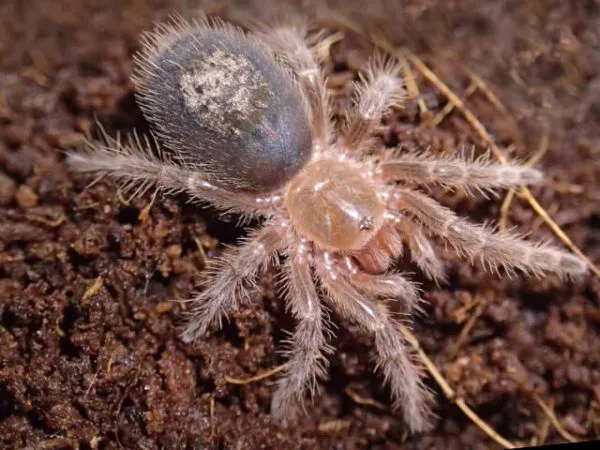
Molting is a natural process for tarantulas, in which they shed their exoskeletons to grow. It is an important part of your Chaco Golden Knee tarantula sling’s life cycle. Understanding the molting process will help you know what to expect and how to best support your pet. Knowledge and observation will help ensure your sling’s health and development.
Preparing for Molting
Before molting, a Chaco Golden Knee tarantula sling may stop eating, become less active, and spend more time in its burrow. The abdomen may appear dark and swollen. Provide a moist environment and do not disturb the sling during this period. Make sure the enclosure is free of any hazards, such as sharp objects, that could injure the sling. Allow the sling to molt undisturbed, and be patient. Ensuring the ideal environment for the molting stage can greatly increase the chances of a successful molt and healthy growth.
Post-Molting Care
After molting, the Chaco Golden Knee tarantula sling’s exoskeleton will be soft and vulnerable. Do not feed the tarantula for at least a week after molting, to allow the exoskeleton to harden completely. Provide fresh water and maintain the appropriate humidity levels. Avoid handling the sling until its exoskeleton is fully hardened. Observe the tarantula’s behavior and watch for any signs of problems. Careful and attentive post-molt care ensures your sling recovers and continues to grow and thrive.
Common Health Issues and Solutions
Like all animals, Chaco Golden Knee tarantula slings can be susceptible to certain health issues. Recognizing the signs of illness and knowing how to address them will enable you to provide the best possible care for your pet. Understanding these issues and taking preventative measures is essential for ensuring a healthy tarantula.
Parasites and Diseases
Chaco Golden Knee tarantula slings can be affected by mites, which can infest the tarantula and the enclosure. Mites can often be seen as small, moving specks. Preventative measures, such as quarantine of new insects and regular cleaning of the enclosure, can help prevent mites. If you notice mites, remove the sling from the enclosure and clean the enclosure thoroughly. Diseases are less common, but fungal infections can occur if the enclosure is too humid or poorly ventilated. If you see any signs of illness, such as lethargy or unusual behavior, consult with a veterinarian experienced in exotic animals.
Preventative Measures
The best way to keep your Chaco Golden Knee tarantula sling healthy is by implementing preventative measures. Maintain proper hygiene in the enclosure, including removing uneaten food, and replacing the substrate regularly. Quarantine new insects before feeding them to your sling to avoid introducing mites or parasites. Monitor humidity and temperature levels and maintain the ideal environment for your sling. Provide a varied diet, and always ensure that the water supply is clean. Regular observation of your tarantula’s behavior and appearance will help you identify any potential issues early on. Preventive care will significantly reduce the risk of health problems and contribute to a happy and healthy tarantula.
Conclusion
Caring for a Chaco Golden Knee tarantula sling can be a rewarding experience that brings you closer to nature. By following the guidelines in this guide, you can create an optimal environment, providing the best possible care for your new pet. Remember to provide a safe, comfortable, and enriching environment, and enjoy the unique experience of observing these magnificent creatures. With patience, diligence, and the right knowledge, you can ensure that your Chaco Golden Knee tarantula sling thrives for years to come. Proper care will allow you to enjoy your tarantula and appreciate its beauty and fascinating behavior.
